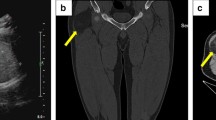Abstract
Neurofibromatosis(NF) is an autosomal dominant systemic disease. Up to 50% of patients with NF are reported to have concomitant vascular abnormalities. In the resection of a larger NF, the risk of uncontrolled hemorrhage is much higher due to the difficulty of hemostasis of large vessels within the tumor. We ligated the base of the giant NF with a simple loop-shaped ligation before removal of the giant NF in both buttocks, following this, we could successfully reduce the amount of hemorrhage during the operation. A 46-year-old female patient presented with giant masses of both gluteal areas, which had been growing slowly for the last 10 years. Each mass was about 35 × 25 cm in size. After designing the elliptical resection margin, we tightened the tumor base by using continuous loop-shaped suture ligation (weaving the thread up and down in a loop-shaped pattern, leaving a space of 2 cm between each loop) a straight needle and prolene 2–0 was used after skin incision. We proceeded with the dissection towards the central and inferior side of the mass obliquely while we avoided opening large vascular sinuses. We resected the tumor in a wedge shape. Subcutaneous tissue was sutured layer by layer, and skin was closed by vertical mattress and interrupted sutures. The loop-shaped ligation of the base was removed, and compressive dressing was done with gauze and elastic bandages. Postoperative complications such as infection, hemorrhage, hematoma, and dehiscence did not occur. Perioperatively, the patient was sufficiently transfused with only two units of blood. During the subsequent 1 year follow-up, the functional and cosmetic results were excellent. A continuous loop-shaped suture ligation procedure along the base of the giant NF effectively reduced the amount of hemorrhage during the operation, made dissection and ligation of vessels easy and quick, shortened the operating time and postoperative recovery time.





Similar content being viewed by others
References
Masocco M, Kodra Y, Vichi M, Conti S, Kanieff M, Pace M, Frova L, Taruscio D (2011) Mortality associated with neurofibromatosis type 1: a study based on Italian death certificates (1995–2006). Orphanet J Rare Dis 6:11
Friedman JM (2002) Neurofibromatosis 1: clinical manifestations and diagnostic criteria. J Child Neurol 17(8):548–554
White N, Gwanmesia I, Akhtar N, Withey SJ (2004) Severe haemorrhage in neurofibromatoma: a lesson. Br J Plast Surg 57:456
Tung TC, Chen YR, Chen KT, Chen CT, Bendor-Samuel R (1997) Massive intratumor hemorrhage in facial plexiform neurofibroma. Head Neck 19:158
Viskochil DH (2001) Neurofibromatosis type 1. Management of genetic syndromes. Wiley–Liss, Inc, New York, pp 229–251
Jett K, Friedman JM (2010) Clinical and genetic aspects of neurofibromatosis 1. Genet Med 12(1):1–11
Halpern M, Currarino G (1965) Vascular lesions causing hypertension in neurofibromatosis. N Engl J Med 273(5):248–252
Jeong WK, Park SW, Lee SH, Kim CW (2008) Brachial artery aneurysm rupture in a patient with neurofibromatosis: a case report. J Orthop Surg (Hong Kong) 16(2):247–250
Salyer WR, Salyer DC (1974) The vascular lesions of neurofibromatosis. Angiology 25:510–519
Kitao T, Miyabo S, Hittori K (1976) Hemophillia associated with von Recklinghausens disease. South Med J 69:16–39
Farah GR, Awidi AS (1985) Massive bleeding in neurofibromatosis with congenital hypofibrinogenaemia. Eur J Surg Oncol 11:57–60
Francis DMA, Mackie W (1987) Life threatening haemorrhage in patients with neurofibromatosis. Aust NZ J Surg 57:679–682
Author information
Authors and Affiliations
Corresponding author
Rights and permissions
About this article
Cite this article
Sapountzis, S., Kim, J.H., Burm, J.S. et al. A safe method for excision of a giant neurofibroma on both buttocks using a loop-shaped suture. Eur J Plast Surg 35, 389–393 (2012). https://doi.org/10.1007/s00238-011-0657-z
Received:
Accepted:
Published:
Issue Date:
DOI: https://doi.org/10.1007/s00238-011-0657-z




